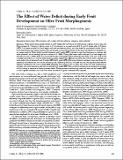Por favor, use este identificador para citar o enlazar a este item:
http://hdl.handle.net/10261/251112COMPARTIR / EXPORTAR:
 SHARE SHARE
 CORE
BASE CORE
BASE
|
|
| Visualizar otros formatos: MARC | Dublin Core | RDF | ORE | MODS | METS | DIDL | DATACITE | |

| Título: | The Effect of Water Deficit during Early Fruit Development on Olive Fruit Morphogenesis |
Autor: | Rapoport, Hava F. CSIC ORCID ; Costagli, Giacomo; Gucci, R. | Palabras clave: | Olea europaea Cell number Cell size Endocarp Mesocarp Water potential |
Fecha de publicación: | ene-2004 | Editor: | American Society for Horticultural Science | Citación: | Journal of the American Society for Horticultural Science 129(1): 121-127 (2004) | Resumen: | Water deficit was applied between 4 and 9 weeks after full bloom by withholding irrigation from 3-year-old Olea europaea L. ('Leccino') plants grown in 2 L containers in a greenhouse. At 6, 8, and 22 weeks after full bloom (AFB), fruit were sampled for fresh weight and volume determinations, and then fixed for anatomical studies. Structural observations and measurements were performed on transverse sections at the point of widest fruit diameter using image analysis. Water deficit applied between 4 and 9 weeks AFB produced a significant decrease in predawn leaf water potential, which reached minimum values of -3.1 MPa. The applied water deficit reduced fruit fresh weight and volume at 8 and 22 weeks AFB. Fruit transverse area of the water deficit treatment was 50%, 33%, and 70% of the irrigated one at the 6-, 8-, and 22-week sampling dates, respectively. Mesocarp growth occurred for both irrigated and water deficit plants between 8 and 22 weeks AFB. At 22 weeks AFB differences between treatments were significant for mesocarp transverse area, but not for endocarp area. Mesocarp cell size, indicated by area, was significantly different between treatments at 8 and 22 weeks AFB. However, the mesocarp cell number was similar for both treatments at all times, and most mesocarp cells were produced by 6 weeks AFB. The growth of endocarp area showed the greatest shift in timing in response to the early water deficit. Ninety percent of endocarp growth had occurred by 8 weeks AFB in the irrigated treatment, but only 40% when the deficit irrigation treatment was imposed. | Versión del editor: | https://doi.org/10.21273/JASHS.129.1.0121 | URI: | http://hdl.handle.net/10261/251112 | DOI: | 10.21273/JASHS.129.1.0121 | Identificadores: | doi: 10.21273/JASHS.129.1.0121 issn: 0003-1062 |
| Aparece en las colecciones: | (IAS) Artículos |
Ficheros en este ítem:
| Fichero | Descripción | Tamaño | Formato | |
|---|---|---|---|---|
| Effect_Rapoport_PV_Art2004.pdf | 639,67 kB | Adobe PDF |  Visualizar/Abrir |
CORE Recommender
Page view(s)
55
checked on 01-may-2024
Download(s)
91
checked on 01-may-2024
Google ScholarTM
Check
Altmetric
Altmetric
Este item está licenciado bajo una Licencia Creative Commons

